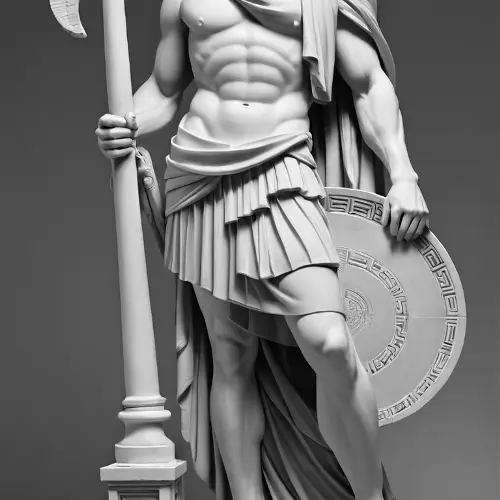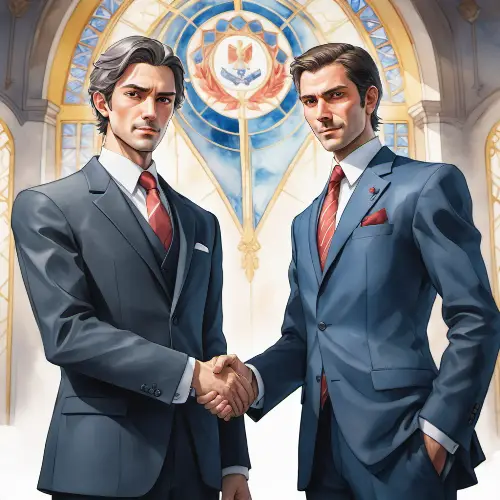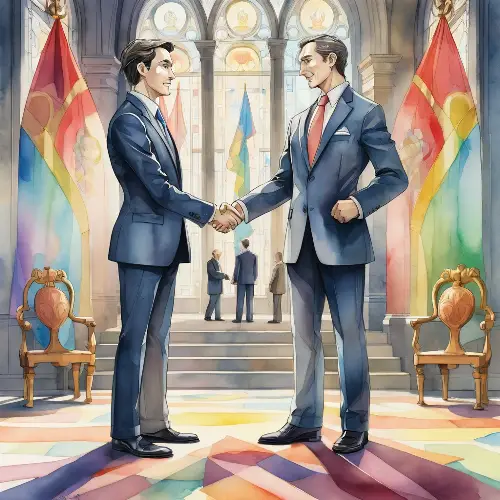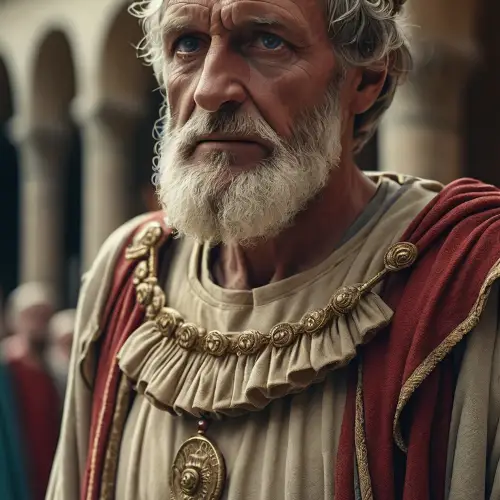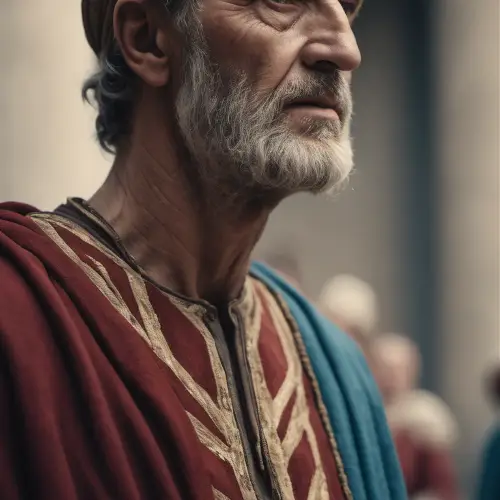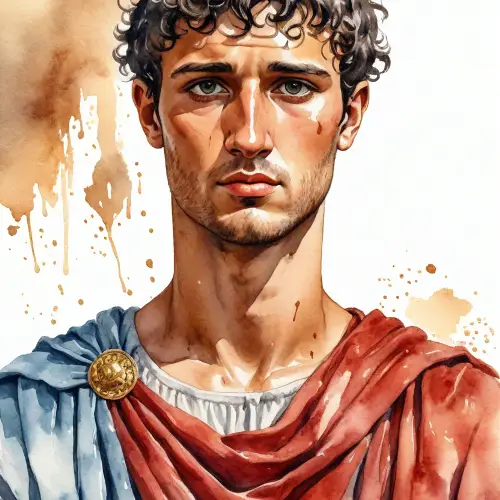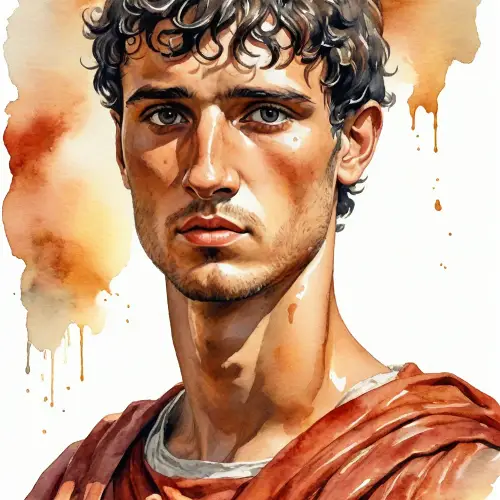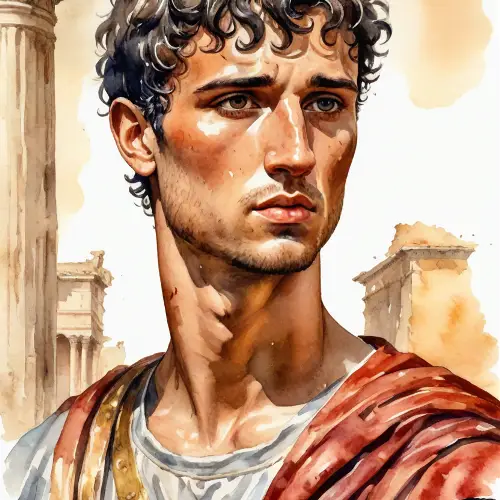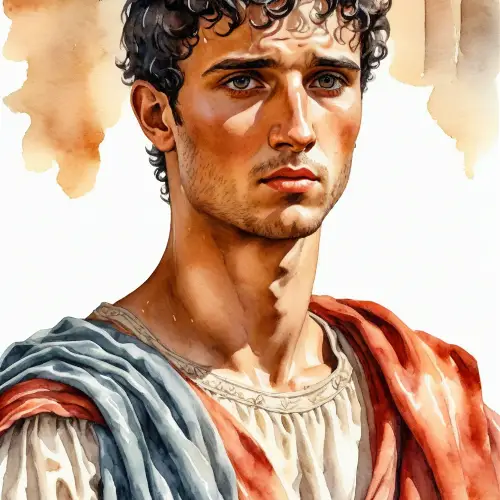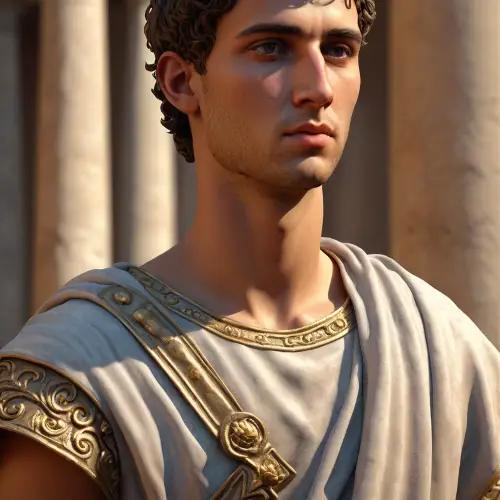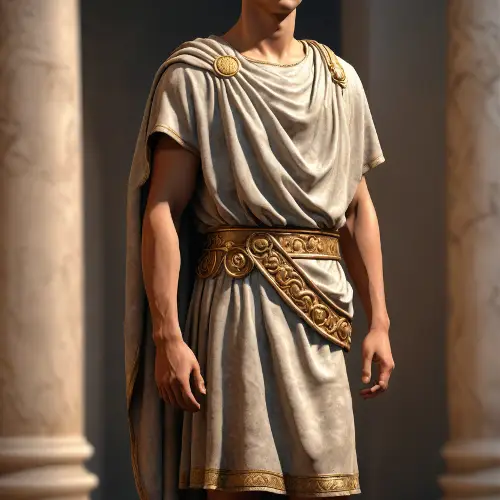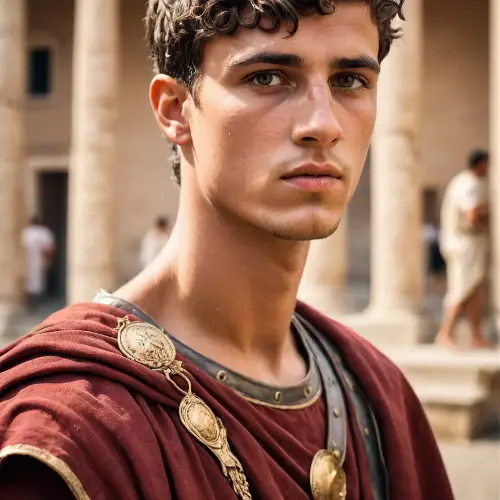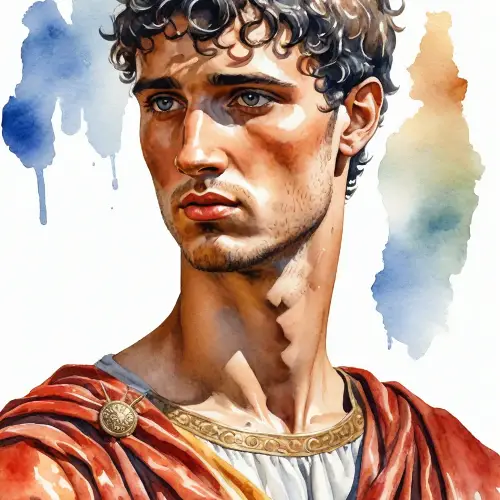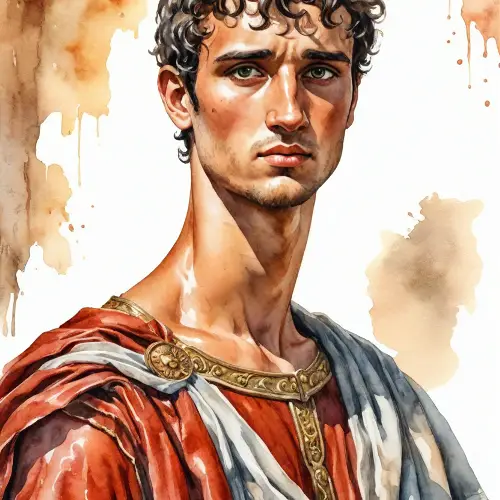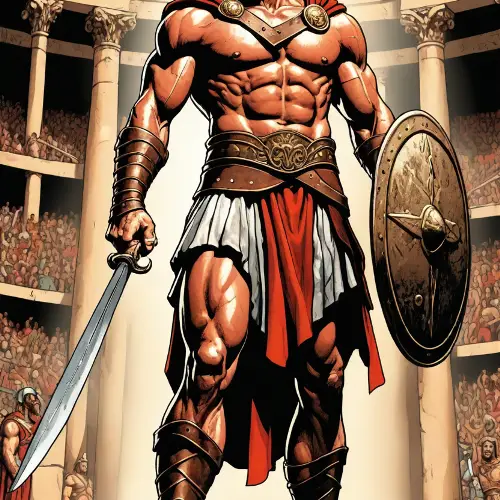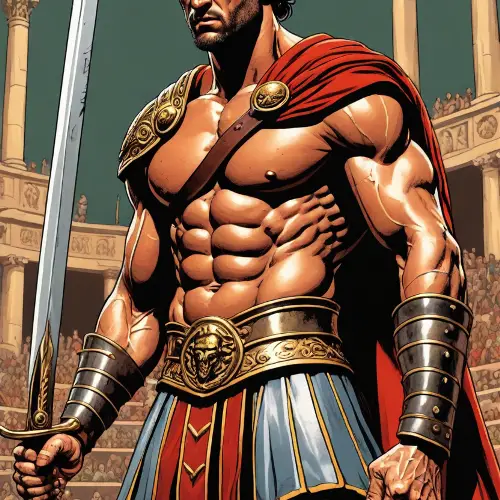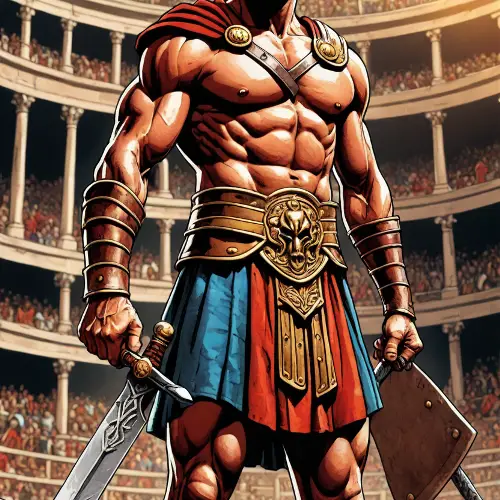In the grand halls of Rome, Octavianus (Octavius), adorned in the regalia of Roman authority, stands with a stoic demeanor. His features reflect a calculated and strategic mind, emphasizing his role as a formidable political adversary.The scene is set against the backdrop of Roman architecture and symbols of power. Octavianus gaze is intense, conveying an air of ambition and determination. The atmosphere is charged with the complexities of political rivalry, as Octavianus emerges as a figure who commands respect and poses a challenge to the aspirations of others, including Antony.
More Like This
Marcus Antonius, known for his charisma and military prowess, stands tall amidst the Roman Senate. His attire reflects a blend of Roman authority and the exotic influences of the East. Antonys expressive eyes convey a mix of confidence and passion, embodying a man deeply connected to the pleasures and complexities of life.The background is adorned with Roman symbols, and the air carries an air of both admiration and apprehension. Antonys commanding presence hints at a multifaceted character, whose allure extends beyond the battlefield to the intricate political landscape of ancient Rome.
In the august halls of the Roman Senate, a mature Marcus Antonius, now in his thirties, commands attention with a commanding presence. Clad in the distinguished attire of a Roman statesman, his features convey a blend of experience and resilience.The room, adorned with symbols of Roman authority, serves as a backdrop to Antonys strategic negotiations and powerful oratory. As he addresses matters of succession and political affairs, his poised demeanor reflects the seasoned leader that has emerged from the tumultuous landscape of Roman politics.
In the august halls of the Roman Senate, a mature Marcus Antonius, now in his thirties, commands attention with a commanding presence. Clad in the distinguished attire of a Roman statesman, his features convey a blend of experience and resilience.The room, adorned with symbols of Roman authority, serves as a backdrop to Antonys strategic negotiations and powerful oratory. As he addresses matters of succession and political affairs, his poised demeanor reflects the seasoned leader that has emerged from the tumultuous landscape of Roman politics.
A dark landscape deeply rooted in ancient Greek society, characterized by its strong connections to stoicism. The black and white palette further emphasizes this connection, as it evokes the timelessness and simplicity of ancient Greek thought. Against this backdrop, the viewer's attention is drawn to a towering statue of a stereotypical strong and muscular Greek man, clad in armor and carrying a shield and spear. His stern expression and regal posture suggest a deep understanding of stoicism and the virtues it embodies, such as courage, self-discipline, and inner strength. The statue's base bears an inscription identifying it as a depiction of Marcus Aurelius, the famous Roman Emperor and Stoic philosopher. The statue towers over the surrounding ancient Greek architecture, which includes columns, archways, and temples that are reminiscent of the Acropolis in Athens. The statue of Marcus Aurelius serves as a testament to the enduring legacy of stoicism in shaping the culture and values of this ancient society.
In the solemn halls of the Roman Senate, a youthful Marcus Antonius, in his late twenties, stands before the assembly. The weight of Caesars legacy rests upon his shoulders as he addresses the senators on the matter of succession, navigating the complexities of Roman politics with a determined gaze.The room, adorned with the grandeur of Rome, witnesses a pivotal moment in history as Antony grapples with the responsibility of determining Caesars rightful heir. The air is charged with anticipation, marking the ascent of a young leader into the intricate world of Roman politics.
In the solemn halls of the Roman Senate, a youthful Marcus Antonius, in his late twenties, stands before the assembly. The weight of Caesars legacy rests upon his shoulders as he addresses the senators on the matter of succession, navigating the complexities of Roman politics with a determined gaze.The room, adorned with the grandeur of Rome, witnesses a pivotal moment in history as Antony grapples with the responsibility of determining Caesars rightful heir. The air is charged with anticipation, marking the ascent of a young leader into the intricate world of Roman politics.
In a dimly lit chamber, Marcus Antonius, burdened by the weight of defeat and political turmoil, contemplates the inevitable. The room, adorned with shadows of Roman insignia, bears witness to Antonys internal struggle as he takes decisive steps toward a fateful resolution.Antony, dressed in the remnants of Roman regalia, moves with a solemn determination. The air is heavy with the echoes of a once-mighty general confronting the consequences of his actions. The scene captures the somber moment when Antony, facing the harsh reality of his circumstances, succumbs to the shadows in a poignant act of self-inflicted destiny.
In the grandeur of the Roman Senate, Julius Caesar stands amidst a circle of senators, his majestic attire contrasting with the stoic expressions of those surrounding him. The air is charged with tension as concealed daggers gleam in the dim light.As Caesar extends a trusting hand, the senators, caught in a moment of betrayal, converge upon him. The swiftness of the attack is captured by the swirling robes and startled expressions. The room echoes with the gasps of realization as the tragic scene unfolds, marking a pivotal moment in history.
In the grandeur of the Roman Senate, Julius Caesar stands amidst a circle of senators, his majestic attire contrasting with the stoic expressions of those surrounding him. The air is charged with tension as concealed daggers gleam in the dim light.As Caesar extends a trusting hand, the senators, caught in a moment of betrayal, converge upon him. The swiftness of the attack is captured by the swirling robes and startled expressions. The room echoes with the gasps of realization as the tragic scene unfolds, marking a pivotal moment in history.
In a secluded chamber, Marcus Antonius, burdened by the weight of his choices, grasps a glinting dagger. The room, shrouded in shadows, bears witness to Antonys inner turmoil as he confronts the inexorable course of fate.Antony, clad in the remnants of Roman regalia, moves with a solemn determination. The air is thick with the gravity of the moment as he raises the dagger, the glint of cold steel reflecting the harsh reality. The scene captures the poignant act of self-inflicted destiny, marking the tragic end of a once-mighty general.
In a dimly lit chamber, the silhouette of the young Marcus Antonius, in his late twenties, is engulfed by shadows as he grapples with a glinting dagger. The room, adorned with fragments of Roman regalia, bears witness to the unfolding tragedy of a once-prominent figure.Antony, his countenance marked by the weight of internal strife, raises the dagger with a solemn determination. The air is thick with the gravity of the moment as he confronts the inexorable course of his destiny. The scene captures the poignant act of self-inflicted tragedy, marking the heartbreaking end of a life once filled with promise.
In the private chambers of Alexandria, the back view of Marcus Antonius in his early thirties unfolds as he stands at a discreet distance, silently observing Cleopatra. The room is adorned with luxurious Egyptian decor, creating an intimate and captivating atmosphere.Antony, dressed in the distinguished attire of a Roman statesman, exudes a sense of contemplation. His posture reflects a mixture of admiration and introspection as he takes in the regal presence of Cleopatra. The scene freezes this moment, capturing the quiet intensity of Antonys emotions from behind.
In the private chambers of Alexandria, the back view of Marcus Antonius in his early thirties unfolds as he stands at a discreet distance, silently observing Cleopatra. The room is adorned with luxurious Egyptian decor, creating an intimate and captivating atmosphere.Antony, dressed in the distinguished attire of a Roman statesman, exudes a sense of contemplation. His posture reflects a mixture of admiration and introspection as he takes in the regal presence of Cleopatra. The scene freezes this moment, capturing the quiet intensity of Antonys emotions from behind.
In the private chambers of Alexandria, the back view of Marcus Antonius in his early thirties unfolds as he stands at a discreet distance, silently observing Cleopatra. The room is adorned with luxurious Egyptian decor, creating an intimate and captivating atmosphere.Antony, dressed in the distinguished attire of a Roman statesman, exudes a sense of contemplation. His posture reflects a mixture of admiration and introspection as he takes in the regal presence of Cleopatra. The scene freezes this moment, capturing the quiet intensity of Antonys emotions from behind.
In the private chambers of Alexandria, the back view of Marcus Antonius in his early thirties unfolds as he stands at a discreet distance, silently observing Cleopatra. The room is adorned with luxurious Egyptian decor, creating an intimate and captivating atmosphere.Antony, dressed in the distinguished attire of a Roman statesman, exudes a sense of contemplation. His posture reflects a mixture of admiration and introspection as he takes in the regal presence of Cleopatra. The scene freezes this moment, capturing the quiet intensity of Antonys emotions from behind.
In a solemn chamber, Julius Caesar, clad in the majestic robes of power, stands unaware as a group of senators, shadows conspiring against him, approach from behind. The dim light accentuates the gravity of the impending betrayal. The cold steel of unsheathed daggers gleams in the shadows, creating an atmosphere of secrecy and impending doom.Caesars silhouette, a symbol of authority, contrasts starkly against the dark backdrop, emphasizing the dramatic and treacherous nature of the scene.
In a dramatic turn of events, the scene unfolds as Julius Caesar, adorned in the regal garments of his time, stands surrounded by Roman senators. The atmosphere is tense in the Senate chamber, and a sense of betrayal lingers in the air. As Caesar reaches out, a sudden and treacherous act unfolds—the senators converge, and the daggers are unsheathed.The dimly lit room witnesses the shocking act of betrayal, capturing the intensity of the moment. Caesars expression reflects both surprise and defiance as the conspiracy unfolds around him.
In a dramatic turn of events, the scene unfolds as Julius Caesar, adorned in the regal garments of his time, stands surrounded by Roman senators. The atmosphere is tense in the Senate chamber, and a sense of betrayal lingers in the air. As Caesar reaches out, a sudden and treacherous act unfolds—the senators converge, and the daggers are unsheathed.The dimly lit room witnesses the shocking act of betrayal, capturing the intensity of the moment. Caesars expression reflects both surprise and defiance as the conspiracy unfolds around him.
In the grandeur of the Roman Senate, Julius Caesar, draped in regal attire, stands unaware of the conspiratorial shadows that encircle him. The senators, cloaked in treachery, close in with daggers concealed beneath their garments.The air is thick with tension as the betrayal unfolds, and Caesar, in a moment of realization, is met with a cascade of lethal blows. The room echoes with the muffled sounds of a struggle, the grandeur of power extinguished in the brutality of political betrayal. The scene captures the tragic climax of the Ides of March, marking the fall of a mighty leader at the hands of those he once trusted.
In the opulent chambers of Alexandria, Marcus Antonius, adorned in Roman attire, finds himself captivated by the mesmerizing allure of Cleopatra. The air is suffused with a delicate fragrance as he, with an enamored gaze, gazes upon her regal form.Cleopatra, draped in luxurious fabrics, meets Antonys eyes with a knowing smile. The room, adorned with Egyptian motifs, bears witness to the subtle dance of emotions between them. The atmosphere is charged with the undeniable chemistry of two powerful figures succumbing to the intoxicating currents of love.
In the opulent chambers of Cleopatras palace, Marcus Antonius, clad in Roman attire, presents a meticulously drawn map of selected regions to Cleopatra. The room is adorned with symbols of both Egypt and Rome, signifying the union of their empires.Antony, with a gesture of respect, offers the map to Cleopatra, highlighting the areas marked for her dominion. The map unfolds to reveal the intricate details of the gifted territories. The scene captures a moment of diplomatic exchange, symbolizing the complex interplay of power and love between two influential figures of the ancient world.
Against the backdrop of Roman opulence, Cleopatra, adorned in resplendent Egyptian attire, engages in a diplomatic dance within the aristocratic circles of Rome. The grand halls echo with the cadence of political discourse as she navigates the complex world of Roman nobility.Cleopatras presence, a fusion of regality and exotic charm, captures the attention of Roman dignitaries. The air is filled with the delicate interplay of diplomacy and intrigue, as the queen strategically forges alliances and cements her influence amidst the marble statues and tapestries of Rome. The scene encapsulates Cleopatras deft maneuvering through the aristocratic tapestry of the Roman elite.
Create an illustration of a 3D wide-anime-style watercolor cartoon scene. Two powerful figures, their faces etched with determination, extend their hands for a handshake. On the left stands a character reminiscent of a confident leader, with a regal posture and piercing eyes. Dressed in a tailored suit with a distinctive pin on the lapel, this figure exudes authority and control. On the right stands another character, exuding calmness and resolve, wearing a formal attire that reflects a sense of diplomacy and poise. The background depicts a grand hall adorned with symbols of power and unity, with flags of their respective nations gracefully draping the walls. Soft, ethereal light filters through stained glass windows, casting a vibrant spectrum of colors onto the scene. The handshake, though seemingly simple, carries the weight of nations as a symbol of peace, cooperation, or perhaps a strategic agreement between two influential entities.
Potrait of Julius Caesar of rome, muscular, aesthetic, wearing traditional roman battle clothes. Striking a powerful pose, masterpiece, work of art, beautiful digital art,
In the Battle of Actium, Octavian adeptly maneuvers his fleet through a precise strategy, depicted in a still-cut scene where his warships deftly penetrate the midst of Cleopatras forces. Octavians naval prowess is evident as his fleet executes coordinated maneuvers and powerful assaults, leaving Cleopatras forces vulnerable and showcasing his tactical brilliance on the turbulent waters of Actium.
hyperrealistic concept art of an attractive 29 year old man, ((full body)) ((in a dynamic pose)) with a sophisticated style and an aura of mystery. The character has long, silver hair in a ponytail. His dark, vibrant green eyes, standing out against his symmetrical face with full lips and sharp, elegant nose. He wears a dark green cloak with golden embroidery of vines and leaves at the hem, edges and hood, fastened at the neck with a metal clasp that sports a green emerald on a bed of golden twigs. Underneath, she wears a white shirt open at the chest, with a thin gold chain joining the edges of the fabric and ruffles gathered at the collar and wrists. Over his left shoulder, he holds a 60 cm long sword, with a design of flowers and vines engraved around the hilt, indicating that he is right-handed. His demeanor is cold and impassive, reflecting his seriousness and dedication to his responsibilities. The expression on his face is confident, but not angry, capturing the essence of a man who carries the weight of the world on his shoulders. The lighting and environment should complement his elegance and mystery, immersing the viewer in an atmosphere of fantasy and majesty, high contrast, cinematic look, cinematic lut, high contrast lighting and shadows.
In the sprawling gardens of Alexandria, Marcus Antonius, from a distance, observes Cleopatra with a gaze filled with a potent mix of admiration and longing. Dressed in the regalia of a Roman general, he stands amidst the vibrant foliage, his eyes fixed on the queen.Cleopatra, unaware of his presence, is surrounded by the beauty of the botanical haven. The soft breeze carries a sense of anticipation as the scene encapsulates the silent dance of emotions between the two. The distance between them becomes a poignant canvas, portraying the complexities of a love that transcends boundaries.
Cleopatra is seated at the center, elegantly poised, with Caesar on one side and Antony on the other. Cleopatra sits gracefully, Caesar stands with authority, and Antony gazes at her passionately. Their attire reflects their origins and status, and the background harmoniously combines elements from both Rome and Egypt, symbolizing the intricate relationships of love and politics among them.
design sketch for a roman warrior, in the style of paul rand, positive and high – definition
Stoicism Marcus Aurelius, retro, body full of strength, black background, clouds, smoke and Roman columns
gladiator from Rome, imposing stature, bulging muscles and intense gaze, standing in the arena with sword in hand, ready for battle
gladiator from Rome, imposing stature, bulging muscles and intense gaze, standing in the arena with sword in hand, ready for battle








